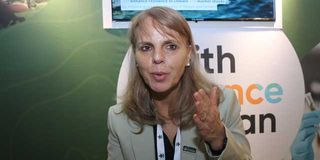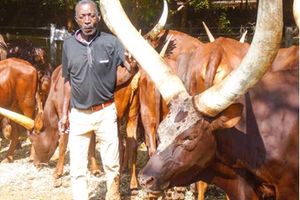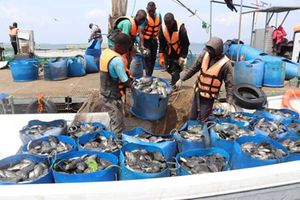
Dr Sandra Milach, the chief scientist at Consultative Group on International Agricultural Research during an interview in Nairobi in this photo taken on April 9, 2025.
The world’s population is projected to hit 10 billion by 2050. Because of this, harnessing breeding strategies for yield improvement will help achieve sustainability and food security. Seeds of Gold writer Richard Maosi speaks to Dr Sandra Milach, the Chief Scientist at the Consultative Group on International Agriculture Research.
Why is breeding of crops and animals important?
In the context of the harsh climate reality with changes in the growth and distribution of plants, animals and insects, breeding is important because of its capacity to improve food output. It aims at introducing and improving desirable qualities in order to suit human requirements. It supports the economic growth of households, communities and countries by improving the genetics of animals.
Crop breeding, for instance, promotes food security. It makes crops resilient to the shocks of climate stress and resistance to pests, diseases, pathogens, untimely floods and droughts.
Breeding and genetics aim to develop plants that are well-adapted to the environment – an important characteristic to boost the nutritional value of crops.
Read: Future of our agriculture lies in science
Which crops are you targeting in Africa?
Maize, sorghum, millet, rice, canola and sunflower are staples in Africa. We help subsistence farmers to change from the ordinary way of developing food and food products to advanced methods. We show them to develop products by addressing issues associated with crop failure, incorporated with seed varieties for crop production and food security.
What are some of the key areas you look at?
The Consultative Group on International Agriculture Research is the largest social capital in public breeding on the planet. Because of that, we have an important role to play in helping farmers improve yields. We work with partners and communities to modernise farming.
We also have an ambition to attend to challenges like poverty, climate change, climate resilience, biodiversity and improving livelihoods.
What are some of the technologies employed in your programmes?
One of them is data and digital transformation. Here, we have built a platform that looks for a way of bringing on board partners. We bring data together to understand some of the intersections of these programmes. With that, we find the right way to disseminate science information to end-users who are mostly the smallholder farmers.
We do it in the right way to present and protect the information generated by research institutions and others.
Artificial intelligence is a global science agenda that needs the right guardrails. We need to do the right things to the farmers we serve. They deserve good advice on the right type of crop and animal production, answers for the available knowledge, new policies and topics on mechanisation.
Other innovations assisting farmers in Kenya are livestock vaccine development, climate-smart maize, wheat and sorghum, enriched sweet potatoes and other tubers, and bio fortified crops and food.
What climate action and synergies has your organisation put in place to enhance sustainability?
There are many actions in the portfolio. One of them is breeding climate-resilient varieties of maize, sorghum and many other crops.
Here, we look at how to develop crops that can adapt to climate change challenges such as disease resistance and tolerance to drought.
We are also helping smallholders define farming systems.
The objective of this is to make farming sustainable in the unreliable weather patterns the world has been experiencing in the recent past. This includes farming with less water than in the past.
Farmers need knowledge on preserving water in multi-functional landscapes.
We are looking at incentives and working with policy makers. The country and the continent need policies that allow the value chains to develop and create more jobs. Farmers need to have more mechanisms to improve their harvests.
How are women and young people in science shaping the future of the world’s agri-food systems?
Gender plays a critical in the agri-food systems. When on breeding systems, for instance, we look at the products.
There is also the aspect of awareness of these products and their contribution to family livelihoods. This brings in the social inclusion agenda. Women, young people and marginalised groups should focus on designing their science and the solutions that they are coming up with. The aim is to avoid creating more inequality.
There are many women scientists too. Many of these scientists are involved directly with producing chicken vaccines.
When it comes to making decisions, we incorporate young people and women. Because of that, we have such an important role of taking care of the farm at household level.
Which avenues do you use to reach small-scale farmers?
We work with communities, the two levels of government and youth groups. Kenya has a vibrant youth community. Young people are the future of the agri-food systems and so we need to engage them in the value chains.
Exactly how are you working with partners?
The Kenya Agricultural and Livestock Research Organization (Kalro) and the International Centre of Insect Physiology and Ecology (Icipe) are main partners we have been working with.
Scientists from the two organisations have closely been working with farmers and providing innovative solutions backed by science. We also work with farmers in the grassroots as they have reliable first-hand experience.
What would you say are your milestones?
The Science Week has been an achievement for CGIAR. The event in Nairobi attracted more than 4,000 people, with two thirds being partners. Its objective was engaging and inspiring scientists, partners, farmers and people of all ages with ideas on Science engineering and technology.
From fragmented markets to regulatory inefficiencies, which other challenges does agriculture face?
Weather changes present problems for farmers. Crop and animal producers now have to contend with increasing temperatures, droughts, flooding and water scarcity. We also need to redesign some of the crops cultivated in order to make agriculture profitable.
It is important that we invest in transforming food and agriculture. Science understands the problems and can come up with innovations and solutions.
More than 800 million people on the globe are hungry. Of this number, some 350 million are in extreme hunger. The root causes of hunger need to be addressed.







